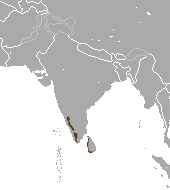Distribution and habitat
In South India, the Indian brown mongoose lives at an elevation range of 700–1,300 m (2,300–4,300 ft) from Virajpet in south Coorg and Ooty in the Nilgiri Hills, Tiger Shola in the Palni Hills, High Wavy Mountains in Madurai, Kalakad-Mundanthurai in Agasthyamalai Hills, Valparai plateau in the Anamalai Hills, and Peeramedu in Kerala. [1] In Sri Lanka, the species is confined to west coast, central hills and western urban centers. [5]
In the 1970s, it has been introduced to Fiji, where it lives in sympatry with the Javan mongoose. [6]
Behaviour and ecology
The Indian brown mongoose is nocturnal in nature, prefers to live in isolation, and maintains its habitats in dense forests. In Sri Lanka, it prefers jungle patches covered with ferns and brush to tea estates. Generally a shy animal that avoid human habitation, but sometimes enter suburban gardens to feed on snakes and mice. When threaten, it will flee to a hole or termitaria but make ferocious fight when cornered. [5]
When ready to breed, Indian brown mongooses burrow in densely-packed rocks and give birth to two to three young. The brown mongoose is opportunistic carnivore, feeding primarily on small rodents, snakes, lizards, spiders, grubs, birds, eggs, frogs and at times also on berries and flowers. [6] During hunting, it stops motionless to detect sound emitted by the prey and quickly pounce on the prey with a bite to head. [5]
Parturition is usually in a burrowing dug well concealed embankment or underneath a rock or an anthill. Female gives birth to three to four pups in any time of the year. [5]
This page is based on this
Wikipedia article Text is available under the
CC BY-SA 4.0 license; additional terms may apply.
Images, videos and audio are available under their respective licenses.


